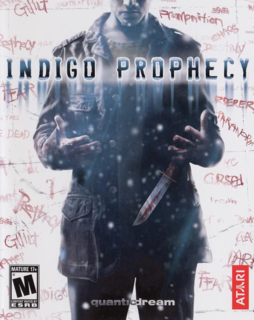Uniqueness is fine, but over simplicity isn't always a good thing.
The game takes place in modern day New York, in January during an unusually heavy amount of snow blizzards. The main character here is seemingly normal Lucas Kane, who is introduced to us through a grusome murder in a New York diner one evening. At the beginning of the game you will see Lucas in one of the diner's restroom cubicles cutting his arms before exiting the cubicle and murdering an unsuspecting man. After this cut sequence you gain control of the character, which is when you must decide on what to do. You will see in a split-screen a cop eating in the diner who eventually gets up and makes his way to the bathroom. Should you hide the body in another cubicle and clean the blood up? or should you just make a break for it out the door? This is the kind of thing you can expect Fahrenheit to throw at you regularly through the course of the game.
The decision making is simple, although you will often find that time is not on your side.
During the course of the game you will also be introduced to a couple more controlable characters which you can choose which to control at various points of the game. Although sadly choosing which to play as doesn't seem to matter anyway since these are split into little chapters and it seems they all need to be done anyway.
Fahrenheit may seem like the regular adventure game, although it's the way that you use your controls which makes it different. You will see icons at the top of your screen with a little blip beside them which will move upwards, downwards, or left and right. When you are next to something which is interactive these icons will appear, and to use them all you do is move the primary control (control stick on consoles) in the direction the icons blip is moving in.
This at first seems like a great way to control the game, and it works, although it's nothing impressive even if it hasn't been done before. Some interactive items in the world will require different movements, for example circular motions for mopping a bloody floor (hint hint).
Another gameplay element in the game are the "Simon Says" style sequences. These are regular points in the game which happen at any time and can range from sequences which need to be completed successfully to progress in the game, to ones which only slightly change the story.
During these sequences the player will see two coloured circles which are divided into four parts each, just like the Simon Says light games. Simply watch the sequence and follow it with your keys or thumbsticks.
The fact that Fahrenheit has no inventory makes it feel a little shallow. The game has no real puzzles, only the afore-mentioned Simon Says sequences, simple decision making tasks and other key pressing rythmic games. To put it short, the game is basically an on-rails movie brought along by these mini-games. You can move your character of course, although the areas which you can move them are very small.
Fahrenheit's graphics are fair. They do the job and the characters look pretty good. There aren't any special DirectX 9 things in here, and the game as a whole looks pretty standard. It actually looks similar to the Hitman series in both art and technology.
The characters in this game are probably the best point of it. This game has some very likable people in it who have great voice acting and often show a decent sense of emotion. This is a good thing for what seems to be the main focal point of Fahrenheit, the story as it really strenghtens it.
Fahrenheit could have been a much deeper game, although it does work, has great characters and story, it's the actual gameplay which lets it down. Sadly it's an adults story which plays like a childrens game. Becuase of this, it's definately best to rent this game out and play it, since it's probably going to dissapoint a majority of people after they finish what is already a fairly short game.

